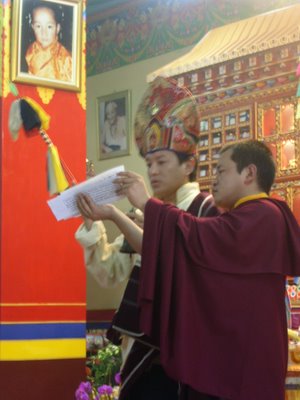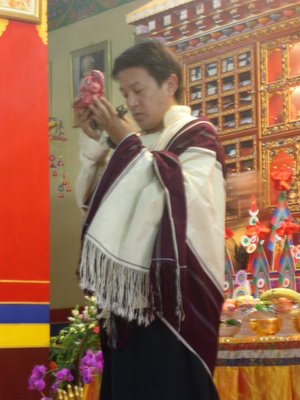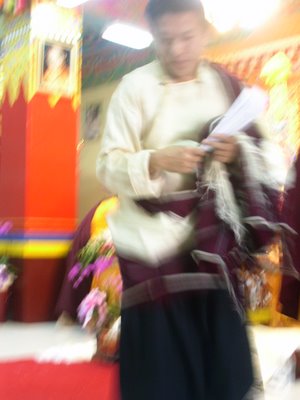L6petasin esimese, ametliku osa oma palverannakust: 8 paevaga 12 Sakyamuni Buddhaga seotud pyhapaika. Tihti 8 tundi paevas India bussis India teedel. Samas- kui m6tlen Buddhast, kes need vahemaad jalgsi labis, ja Khamtul Rinpoche'st, kes 80-aastasena meiega koos selle rannaku tegi, pole see ko"o"meski. Tempost hoolimata oli see s6nulseletamatult v6imas aeg.
Yleeile saabusin McLeod Ganj'i- eelnevaga v6rreldes kuurorti. Rinpoche j6udis tagasi eile. Vapustavad elamused jatkuvad, aga neist me ei raagi. Muuhulgas naen toaaknast hommikuti paikeset6usu lumistel Himaalaja tippudel ja all orus Dharamsala pisilinnas, ja teisel pool, jargmisel k6rgendikul, Dalai Lama residentsi ja templit. Eile kaisin seal tema labi viidud initsiatsioonil, kus olid ka jarjekordsed paarsada asja Tiibetist saabunud p6genikku.
Happy New Year! 新年快樂!
Sunday, January 29, 2006
Saturday, January 14, 2006
The Three Types of Pilgrim
by Kathok Situ Chökyi Gyatso

Without desires, attachment, or any particular agenda or itinerary,
With no selfish concerns, simply roaming freely from place to place
For the sake of others, benefitting impartially those to be trained—
This is the way of the very best type of pilgrim.
Following holy masters who are non-sectarian and free from faults,
Receiving their Dharma teachings without sectarian bias or conflict,
And gathering virtue in sacred places without partiality or attachment—
This too is the way of the superior pilgrim.
Through devotion for the representations of enlightened body, speech and mind,
Tirelessly amassing merit in every monastery, hermitage and sacred site,
With pure perception and without ever quarrelling or losing heart—
This is the approach of the middling type of pilgrim.
Firstly making grand promises and plans to travel the globe,
Then passing by sacred sites which are reached by uphill roads,
In the end, being content with having ‘been there’ and ‘done that’—
This is one aspect of the meaningless type of pilgrimage.
Never seeing the virtues of the sangha, but noticing their each and every fault,
Never coming close to sacred images and texts, but viewing them from a distance,
Requesting souvenirs when others are around and stealing them when they are not—
This is the second way in which a pilgrimage becomes nothing but an evil outing.
Developing wrong views towards a sacred place when feeling tired,
Or visiting a temple one day and forgetting all about it the next,
Getting angry along the way and considering it a sign of courage—
Avoid all such ‘pilgrimages’, which are merely futile forms of exertion.
In India, the sacred land of the Aryas,
Many masters still remain, hidden and apparent,
And so, filled with faith and devotion,
I prostrate and make prayers and aspirations.
*Kathok Situ Chökyi Gyatso was a nephew and spiritual heir of the great Jamyang Khyentse Wangpo and a teacher of Jamyang Khyentse Chökyi Lodrö and many other important masters. He is well known for his pilgrimage guide to Central Tibet.
Friday, January 06, 2006
H.H. Garab Dorje Rinpoche's Long-Life Ritual for H.E. Khochhen Rinpoche, December 27,'05 in TaiZhong

A rare sight: GDR wearing his ritual hat

Performing long life ritual;
on the pillar, photograph of young Dudjom Rinpoche;
on the wall, Dilgo Khyentse Rinpoche

帥哥仁波切 offering to his teacher in Mindrolling, Khochhen Rinpoche

Dharma in motion :)
Subscribe to:
Posts (Atom)

